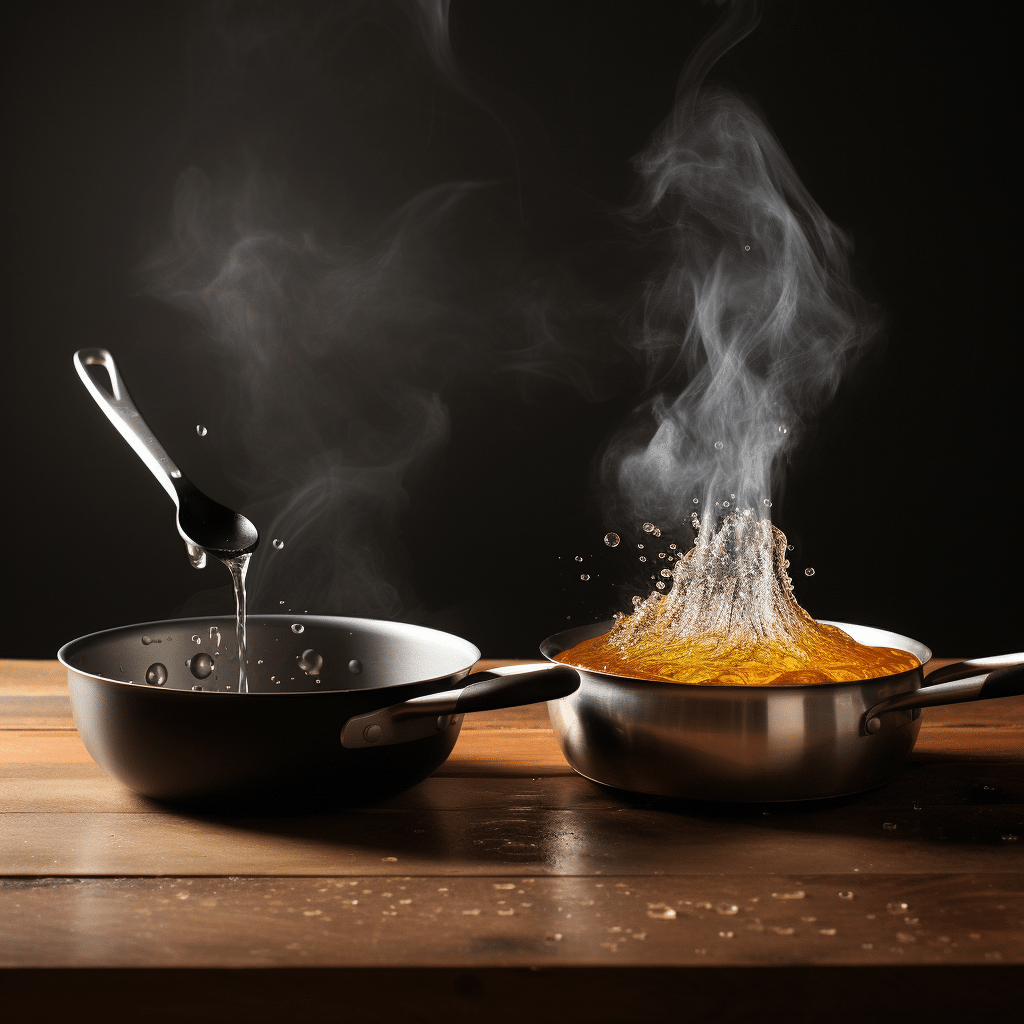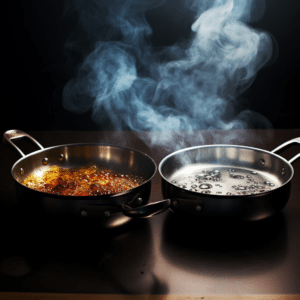
Skillet vs Saucepan
Skillet vs Saucepan: Choosing the ideal cookware can be challenging, especially if numerous variations exist. Pans, for example, come in a wide variety, each having its preferred cooking method. The same is valid for skillet and saucepan. These two have some similarities, but each is used differently in culinary.
Differentiating a saucepan from a skillet would require looking at the cookware’s material, shape, and function. Doing so gives you the extra knowledge on the right pan you should use for your specific cooking method. And although a skillet and a saucepan can sometimes be used interchangeably, they are not the same. Here’s a closer look at skillet vs. saucepan.

Skillet vs Saucepan: Overview
Skillets and saucepans look almost similar. The two have flat-bottomed cookware with tapered or straight sides. They have a long handle and sometimes come with a short helper handle on the opposite side. The main difference is in the height of the sides in relation to the diameter.
Skillet has a smaller height, slightly bigger than a frying pan but smaller than a saucepan. For this reason, it’s best used for frying and sauteing.
A saucepan has a bigger height compared to its diameter. It, therefore, is best used to cook anything liquid, like sauces, making stews, pasta, boiling grain, or cooking small portions of food.
About Skillet
Skillets are shallower than saucepans, come with a lid, and have curved and sloped sides. This makes them have a large surface area compared to height. The skillet’s short slanted sides are the most notable defining feature of skillets.
Many different types of materials are used to make skillets—for example, aluminum, copper, stainless steel, and cast iron. The cast iron skillet is among the most popular skillets, thanks to its benefits. Some skillets have a non-stick inner surface while others don’t.
Skillets are mainly used for frying or braising thick sauces and curries. You can use them for making eggs, frying foods, or cooking meat. These pans hold heat well, making them a good choice for grilling.
About Saucepan
Saucepans, which come in different sizes, are deeper than skillets and have a bigger height than their diameter. These pans can be categorized as small, medium, large, or extra large. The height is the unique selling point of these pans and keeps increasing as the size increases.
The smallest size of a saucepan has a 15 cm diameter and a capacity of 1 quart to 2.25 quarts. On the other hand, the largest size of a saucepan has a capacity of up to 7 quarts for commercial kitchens. If you prefer anything larger than this, I’d suggest you go for a stockpot. The stockpot seems like a larger version of a saucepan, and some saucepans are stocky, making them look like stockpots.
Generally, saucepans come with lids. The lids, plus the narrow base and high sides, make these pans perfect for cooking liquid foods and making sauces. These three features, lid, high height, and narrow base, ensure the liquids cook better and don’t evaporate.
Differences Between A Skillet And A Saucepan
The most notable difference between a skillet and a saucepan comes from their volume, surface area, evaporation, and tossing abilities.
Surface Area
Most cookware is measured according to its diameter. A skillet has a slightly bigger diameter than a saucepan. This makes it have a larger surface area for cooking, making it ideal for frying foods.
A saucepan has a smaller surface area and so a smaller cooking area. For this reason, saucepans are not great for frying. And if you fry your food in a saucepan, the food will clump together, giving you a bad frying experience.
Volume
The height of the straight sides of a pan determines its volume. Pans with bigger straight sides hold more volume than their fellow counterparts.
Skillets have smaller straight sides than saucepans. This means they hold less liquid. The liquid is also likely to splash out when you transfer the pan in and out of the oven or move it around.
Saucepans are deeper with larger straight sides, making them capable of holding more liquid than skillets. The large volume capacity also ensures the liquid doesn’t move out when cooking and that the lid fits more tightly when cooking. This help minimizes evaporation.
Tossing Abilities
Skillets are superior at sauteing food than saucepans. Sauteing involves cooking small to medium-sized pieces of food rapidly in hot oil with constant agitation. The skillet’s sloping sides and lighter weight let you quickly shake the pan, tossing the food inside it. This effectively redistributes the cooking food, ensuring all the pieces in the pan get even cooking.
Although you can saute in a saucepan, that’s not easy and requires constant stirring and turning using a spatula or a wooden spoon, and the results may also not be as great as if you’re using a skillet.
Evaporation
The shape of a pan affects how easily moisture is driven off food and how quickly a sauce reduces. The skillet’s low-sloped sides help moisture from the cooking food evaporate more rapidly, letting you sear more efficiently. However, if making a liquid-based dish, this will work to your disadvantage.
Saucepans have higher sloped sides, making the cooking food inside not lose a lot of moisture. This works great when making liquid-based foods like sauces but may be a disadvantage when frying.

Can You Use A Skillet Instead Of A Saucepans
No, you cannot use a skillet in place of a saucepan. And here’s why:
- Saucepans retain texture, moisture, and color to your cooked dish, giving you the best-steamed meal. Skillets draw out excess liquid, making foods release their natural oils.
- You can deep fry using a skillet, but a saucepan will give you a better experience. The saucepan’s deep surface lets oil cover the food better than a skillet, giving you the best deep frying experience.
Conclusion
A skillet and a saucepan are two different cookware serving individual purposes. The former is best used for frying and sauteing, while the latter is ideal for making sauces and other liquid-based foods.